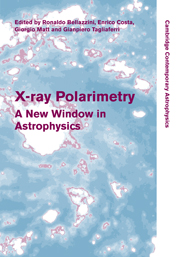Book contents
- Frontmatter
- Contents
- List of contributors
- Preface
- 1 X-ray polarimetry: historical remarks and other considerations
- Part I Polarimetry techniques
- Part II Polarized emission in X-ray sources
- 14 Probing strong gravity effects with X-ray polarimetry
- 15 X-ray polarization from black holes in the thermal state
- 16 Strong-gravity effects acting on polarization from orbiting spots
- 17 Polarization of thermal emission from accreting black holes
- 18 X-ray polarimetry and radio-quiet AGN
- 19 The soft X-ray polarization in obscured AGN
- 20 The polarization of complex X-ray sources
- 21 Polarization of Compton X-rays from jets in AGN
- 22 Polarization of X-ray lines from galaxy clusters and elliptical galaxies
- 23 Polarization characteristics of rotation-powered pulsars
- 24 Polarized X-rays from magnetized neutron stars
- 25 Polarization properties of X-ray millisecond pulsars
- 26 X-ray polarization signatures of neutron stars
- 27 Polarization from the oscillating magnetized accretion torus
- 28 X-ray polarization from accreting white dwarfs and associated systems
- 29 Polarization of pulsar wind nebulae
- 30 X-ray polarization of gamma-ray bursts
- 31 Central engine afterglow from GRBs and the polarization signature
- 32 GRB afterglow polarimetry past, present and future
- 33 Gamma-ray polarimetry with SPI
- 34 INTEGRAL/IBIS observations of the Crab nebula and GRB 041219A polarization
- 35 Fermi results on the origin of high-energy emission in pulsars
- 36 Diagnostics of the evolution of spiral galaxies in a cluster environment
- Part III Future missions
- Author index
- Subject index
21 - Polarization of Compton X-rays from jets in AGN
from Part II - Polarized emission in X-ray sources
Published online by Cambridge University Press: 06 July 2010
- Frontmatter
- Contents
- List of contributors
- Preface
- 1 X-ray polarimetry: historical remarks and other considerations
- Part I Polarimetry techniques
- Part II Polarized emission in X-ray sources
- 14 Probing strong gravity effects with X-ray polarimetry
- 15 X-ray polarization from black holes in the thermal state
- 16 Strong-gravity effects acting on polarization from orbiting spots
- 17 Polarization of thermal emission from accreting black holes
- 18 X-ray polarimetry and radio-quiet AGN
- 19 The soft X-ray polarization in obscured AGN
- 20 The polarization of complex X-ray sources
- 21 Polarization of Compton X-rays from jets in AGN
- 22 Polarization of X-ray lines from galaxy clusters and elliptical galaxies
- 23 Polarization characteristics of rotation-powered pulsars
- 24 Polarized X-rays from magnetized neutron stars
- 25 Polarization properties of X-ray millisecond pulsars
- 26 X-ray polarization signatures of neutron stars
- 27 Polarization from the oscillating magnetized accretion torus
- 28 X-ray polarization from accreting white dwarfs and associated systems
- 29 Polarization of pulsar wind nebulae
- 30 X-ray polarization of gamma-ray bursts
- 31 Central engine afterglow from GRBs and the polarization signature
- 32 GRB afterglow polarimetry past, present and future
- 33 Gamma-ray polarimetry with SPI
- 34 INTEGRAL/IBIS observations of the Crab nebula and GRB 041219A polarization
- 35 Fermi results on the origin of high-energy emission in pulsars
- 36 Diagnostics of the evolution of spiral galaxies in a cluster environment
- Part III Future missions
- Author index
- Subject index
Summary
We investigate the polarization of Compton scattered X-rays from relativistic jets in active galactic nuclei (AGN) using Monte-Carlo simulations. We consider three scenarios: scattering of photons from an accretion disk, scattering of cosmic microwave background (CMB) photons, and synchrotron self-Comptonization (SSC) within the jet. For Comptonization of thermal disk photons or CMB photons the maximum linear polarization attained is slightly over 20% at viewing angles close to 90°. The value decreases with the viewing inclination. For SSC, the maximum value may exceed 80%. The angle dependence is complicated, and it varies with the photon injection sites. Our study demonstrates that X-ray polarization, in addition to multi-wavelength spectra, can distinguish certain models for emission and particle acceleration in relativistic jets.
Introduction
Observations of extended jets in AGN by Chandra have revealed that the origins of their X-ray emission is less trivial than previous thought (see for X-ray jet surveys). The X-rays may arise from various processes. The polarization in the radio and optical bands suggests that the emission is generated by the synchrotron process. Thus, synchrotron and synchrotron self-Compton (SSC) emission are candidates for the X-ray continuum emission. However, the X-rays can also be generated from external Comptonization (EC) of disk black-body radiation or of the CMB. It has been suggested that X-ray polarization measurements are able to discriminate these competing emission mechanisms.
- Type
- Chapter
- Information
- X-ray PolarimetryA New Window in Astrophysics, pp. 142 - 145Publisher: Cambridge University PressPrint publication year: 2010

